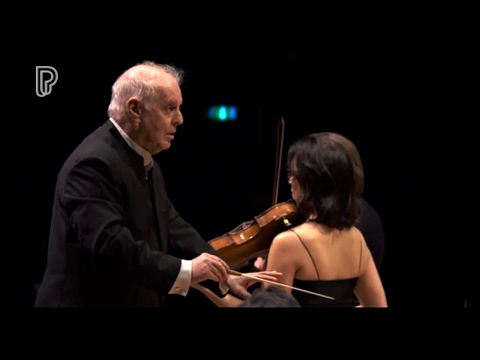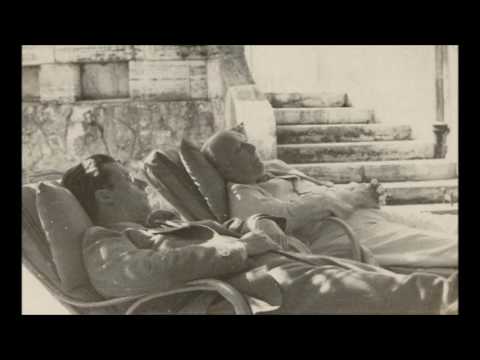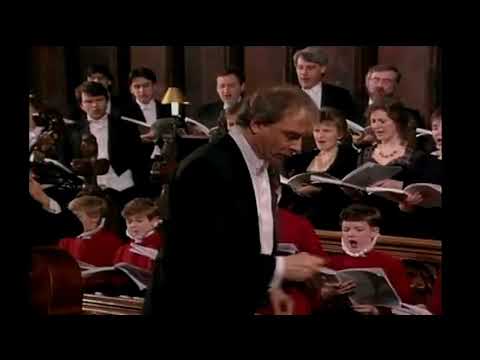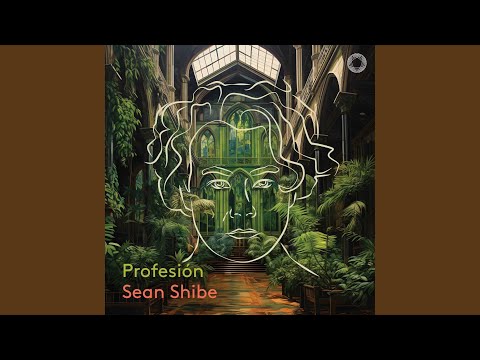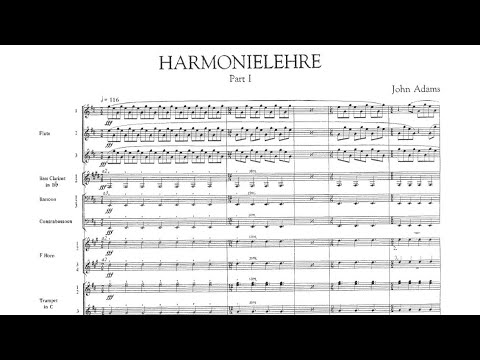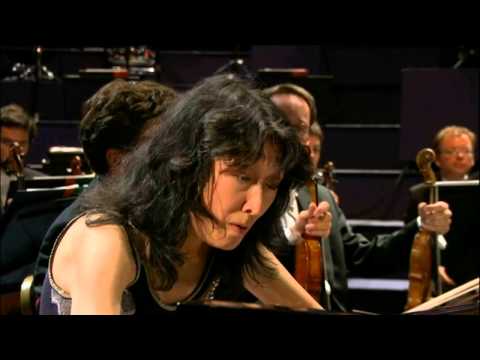Some pieces of music burst into life with feats of virtuosic daring; others rumble up from the bowels of the earth; some loom over you hieratically. Many beginnings are defined by some brilliant melodic gesture: Strauss’s “Don Juan,” for instance, scales the orchestra with a kind of priapic triumph.
As a miserable year comes to an end, it’s a good opportunity to think about how to begin the next. Hopefully we can take inspiration from the opening chords below.
Wolfgang Amadeus Mozart: Sinfonia Concertante for Violin, Viola, and Orchestra in E-flat major, K. 364 (1779)
There are quite a few E-flat major chords which could feature on a list like this. For Wagner, in “Das Rheingold,” it is the sound of the watery abyss from which creation is born, a single harmony lasting nearly four minutes. Beethoven can claim two: the defiant call to attention that inaugurates the “Eroica” Symphony, and the equally revolutionary beginning to the “Emperor” Concerto, that sees the soloist push aside the orchestral exposition for a display of their brilliance.
Mozart’s “Sinfonia Concertante” starts with exquisite understatement. As a violist himself, Mozart created a work that finally gave the instrument equal billing with the violin. (If you have played the viola in a Haydn string quartet, then you know what it is like to be the filling in a sandwich.) The Sinfonia Concertante’s opening chord has an unusually dark and mellow glow, which comes from making the other instruments of the orchestra play in the viola’s register, its naturally resonant home turf. No one in the orchestra plays higher, a beautiful nod of respect and deference towards the generous warmth and richness of the viola’s sound. The violas themselves are divided into two groups throughout the work—a trick Mozart would use at the top of Symphony No.40—which reorients the piece’s entire sound world around the unctuous middle they inhabit.
It is tempting to engage in some Peter Shaffer-esque psychoanalysis about Mozart’s centering of the viola over the violin. His father Leopold was of course a master violinist, writing an important treatise on the instrument, and rather domineering; perhaps Mozart was trying to get one over on his old man.
Richard Strauss: “Elektra” (1909)
The D minor chord that opens “Elektra” isn’t technically the most interesting one in Strauss’s modernist family bloodbath. That privilege is reserved for the bitonal cluster associated with the opera’s manic heroine, an eye-widening blend of E major and C-sharp minor. But before that comes the one-two-three punch combo of the beginning that sets out a simple D minor triad. It has an austere Classical authority that encapsulates Elektra’s father Agamemnon, who exerts a tyrannical posthumous hold. D minor is our point of diatonic departure into a world of harmonic experimentation that Strauss ultimately abjured in the autumnal, reconciliatory poise of “Der Rosenkavalier.”
This opening makes use of almost the entirety of this vast orchestra—except the flutes, who enter by trilling garishly in their lower register a few bars later. After the opening D minor, brass and woodwinds fall away to leave the timpanist, accompanied by the pitchless shudder of the bass drum; after they recede in turn, the bass clarinet oozes. I’ve seen two productions of “Elektra” that begin with the servants scrubbing away at blood that suppurates through the palace floor. Turns out you can hear it in the orchestra.
The latest from VAN, delivered straight to your inbox
Franz Joseph Haydn: “The Creation” (1798)
One of Haydn’s last major works, “The Creation” begins with chaos. The formless void before matter is represented by a huge, unison C across the orchestra. Haydn writes a fermata over the note, so it has no pulse. It’s a world before time, before Day was divided from Night. As the King James Bible puts it: “And the earth was without form, and void; and darkness was upon the face of the deep.” A single C has no meaning, in this musical system, without a fifth or third to define its harmonic place. There is no firmament, no dry land, nothing to divide the waters.
From this first note, the vestiges of harmony start to emerge, like a rainbow gradually refracted through a prism and turned in the light: a minor third in the cellos and violas, a wider major sixth between the violins, before an aching, dissonant diminished seventh chord—the birth pangs of the world. Haydn is meticulous in hiding the big reveal. When we finally get there, and when the moment is executed correctly, audience members genuinely jump out of their seats.
Alberto Ginastera: Sonata for Guitar (1976)
Before you get to the first notes of Ginastera’s Sonata for Guitar, there are two pages of technical instructions in the score: striking the strings with open or closed fist, notes on “indeterminate” groupings of notes or chords at the highest pitches, and the creation of “whistling sounds.” The first chord, however, is simply the open strings of the instrument strummed from bottom to top and left to ring.
Ginastera was one of the most important Argentinian composers of the 20th century, and, somewhat like Pablo Picasso with Spanish culture, incorporates various elements of the Gauchesco tradition, especially folk music, in more and less abstract or complex ways across his work. Because of its shape, the guitar is often used as a metonym in the iconography of Argentine nationalism for the woman who represents the motherland. Given its potent symbolism and centrality to the musical culture, it is extraordinary that Ginastera did not compose anything for the instrument until late in his career. The simple gesture of strumming the open strings represents the culmination of an entire musical and political project: the long reverberation calling a nation into being.
György Kurtág: “Stele” (1994)
Simon Rattle described “Stele” as “a gravestone on which the entire history of European music is written.” Many of Kurtág’s works are valedictory. This includes explicit tributes, as in the many “In Memoriam” piano miniatures included in “Játékok,” as well as works that drape a funeral veil over forms themselves, such as his opera “Fin de partie,” made from the bleached bones of Monteverdi and whispers of Parisian street music.
Stele means “memorial tablet.” Its opening chord—bare octaves in woodwinds, brass, and strings—echoes the one that begins Beethoven’s “Leonora” overture. That overture, in turn, prefaced Beethoven’s great Enlightenment paean to human freedom and dignity, “Fidelio,” in which Florestan is lifted from his dank dungeon to the radiant heights of emancipation.
The first beat is together, but then things start to sour and droop. Kurtág instructs players to bend the pitches: not more than a quarter-tone, vibrating slowly. Trombones join in the second bar, and start to slide inexorably, queasily upwards; double basses leap to harmonics in their highest register, which shimmer like radiation. It’s the sound of Romanticism—all that hope and heroism—decomposing. Part of Kurtág’s inspiration for the piece was the passage in War and Peace where Prince Andrei lies wounded on the battlefield of Austerlitz, staring up at the sky.
John Adams: “Harmonielehre” (1985)
John Adams’s 1985 orchestral work “Harmonielehre” begins with the same E minor chord hammered out 11 times—and then some more for good measure. It was a clear repudiation of the serialist consensus that still mostly reigned supreme in academic composition departments. The decisive repetitions signal the strength of his conviction—that tonality still has something to say—as well as showcasing its thrilling expressive force. The low, anchoring E in the double basses continues mostly uninterrupted for the first minute of the piece, before the chords return. In case you hadn’t got the message.
E minor has a powerful symbolic currency, connecting Adams’s piece to Brahms’s Symphony No. 4 and Dvořák’s Symphony No. 9, “From the New World.” Adams was intensely aware of his position as an American composer brokering a marriage between the West Coast minimalist idiom and the late Romantic, central European traditions of tonality and symphony. “Harmonielehre” is of course named for Schoenberg’s famous textbook, though surely without the implication of dogma—Adams is seldom conventional in the way he traverses the various harmonic fields that make up his music (though neither, of course, was Schoenberg).
That there are 11 shots fired in the first salvo of E minor chords might have its own significance. It is the same number, perhaps coincidentally, as in the famous 11/4 bar of hammer blows in the second part of Stravinsky’s “Le sacre du printemps”—it could also be a gesture to the 12 tones of the chromatic scale. Perhaps a hint from Adams that he hasn’t turned his back on the furious energies of the avant-garde entirely.
Ludwig van Beethoven: Piano Concerto No. 4 in G major, Op.58 (1808)
Though it has been over 200 years since the premiere of Beethoven’s Fourth Piano Concerto, there are still relatively few examples of the form that start quietly; even fewer with piano alone. Beethoven does both, with a convention-defying gesture: an impeccably understated and inward G major chord in the middle of the piano. Pianists often debate whether to give the opening chord a harp-like spread or whether to simply play it straight; the latter strikes me as even more disarming and unearthly.
The orchestra is so amazed at this happening that they enter in B major—distant harmonic territory that makes them sound oddly out of place, as if they are awkwardly intruding on something extremely private, or that they can’t quite fit themselves to the fragile expressive world the soloist summons. It takes several bars for them to recover their confidence and get the concerto underway.
Though it belongs to the middle period of Beethoven’s work, it presages the aesthetic revolution of his late period. There is a powerful sense of the artist as one possessed of something visionary. Beethoven knew when creating his late works that the audience for them perhaps did not yet exist; in them, incomprehensibility is a conscious aesthetic strategy. Perhaps this is why the orchestra is so wrong-footed by this strange spirit at the beginning of the concerto.
Pauline Oliveros: “Horse Sings from Cloud” (1975)
It’s not exactly clear where the first chord of Pauline Oliveros’s “Horse Sings from Cloud” begins or ends. Starting with a single B-flat on accordion (in the version recorded for her 1982 album “Accordion and Voice”), eventually a fifth is added below, a fourth above, and then the same note in the voice. As the fourths and fifths gather, so too do the overtones, which cause the once still tone to start shimmering and vibrating, like a cosmic harmonium. Finally, other intervals grow the harmony into something yet more complex.
As one of Oliveros’s “Sonic Meditations,” the piece is a studio for Deep Listening, which is generated out of the single tone at the beginning and essentially sustained throughout. “Sustain a tone or sound until any desire to change it disappears,” Oliveros writes in her performance instructions. “When there is no longer any desire to change the tone or sound, then change it.”
Many of the chords on this list have an impact because they incite drama and tension; this is a chord that instead asks us to relinquish expectations about music as a succession of events trumping each other in expressive intensity. The piece, Oliveros said, “taught me to listen to the depth of a tone and to have patience. Rather than initiating musical impulses of motion, melody and harmony I wanted to hear the subtlety of a tone taking space and time to develop.” Perfect for clearing your mind amid the festive tumult. ¶
Subscribers keep VAN running!
VAN is proud to be an independent classical music magazine thanks to our subscribers. For just over 10 cents a day, you can enjoy unlimited access to over 875 articles in our archives—and get new ones delivered straight to your inbox each week.
Not ready to commit to a full year?
You can test-drive VAN for one month for the price of a coffee.


